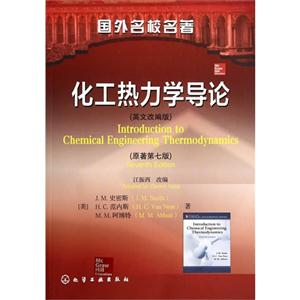化工热力学导论-(原著第七版)-(英文改编版)
本书特色
[
smith教授等编著的《化工热力学导论》是世界化工领域影响*大、发行范围*广的化工热力学教材。本书是根据英文原版书《化工热力学导论》第7版改编。
改编书选取了原书前13章,内容涵盖了化学工程师专业教育所必需的内容。全书主要内容包括以下几个方面:热力学基本概念和基本定律、纯流体的pvt性质、热效应、纯流体的热力学性质、热力学在流动过程中的应用、热力做功、制冷、汽液平衡、溶液热力学理论和应用以及化学反应平衡。这13章内容可以分为三部分:热力学和化学热力学基础,包括第1-6章;热力学在工业过程中的应用,包括第7-9章;热力学在化学过程中的应用,包括第10-13章。书中给出了大量既有理论意义,又切合工业实际的例题,并配有大量来自工业实践的习题。
全书行文流畅、图表丰富、通俗易懂。可作为化学工程与工艺专业以及其他相关专业的化工热力学教科书,也可以作为相关专业研究人员,工程设计和生产管理技术人员的重要参考书,也可以用作化工专业英语的教材或选读材料。
]
作者简介
[
江振西,Zhenxi Jiang,郑州大学教授。1954年7月生于河北省磁县。1975年入郑州工学院(现郑州大学)化工系就读无机化工专业。1978年考入新乡师范学院(现河南师范大学)化学系物理化学专业。1981年毕业于新乡师范学院,获研究生毕业证书,1982年获武汉大学理学硕士学位。1982年3月起在郑州工学院任教,主教化工热力学等课程。1989年获中国政府、包玉刚基金会和英国政府共同设立的中英友好奖学金赴英国利兹大学访问研究。1990年获英国海外留学生奖学金和利兹大学Tetley and Lupton 奖学金读博士学位,1994年获利兹大学哲学博士学位。之后继续在利兹大学从事研究工作。2006年开始,在郑州大学教授化工热力学(双语)课程、研究生专业英语和研究生高等化工热力学(全英语)等课程。
]
目录
list of symbolsprefacechapter 1 introduction 1.1 the scope of thermodynamics 1.2 dimensions and units 1.3 measures of amount or size 1.4 force 1.5 temperature 1.6 pressure 1.7 work 1.8 energy 1.9 heat key notes glossary and explanations conceptual problems problems chapter 2 the first law and other basic concepts 2.1 joule’s experiments 2.2 internal energy 2.3 the first law of thermodynamics 2.4 energy balance for closed systems 2.5 thermodynamic state and state functions 2.6 equilibrium 2.7 the phase rule 2.8 the reversible process 2.9 constant-v and constant-p processes 2.10 enthalpy 2.11 heat capacity 2.12 mass and energy balances for open systems key notes glossary and explanations conceptual problems problems chapter 3 volumetric properties of pure fluids 3.1 pvt behavior of pure substances 3.2 virial equations of state 3.3 the ideal gas 3.4 application of the virial equations 3.5 cubic equations of state 3.6 generalized correlations for gases 3.7 generalized correlations for liquids key notes glossary and explainations conceptual problems problems chapter 4 heat effects 4.1 sensible heat effects 4.2 latent heats of pure substances 4.3 standard heat of reaction 4.4 standard heat of formation 4.5 standard heat of combustion 4.6 temperature dependence of δh 4.7 heat effects of industrial reactions key notes glossary and explainations conceptual problems problems chapter 5 the second law of thermodynamics 5.1 statements of the second law 5.2 heat engines 5.3 thermodynamic temperature scales 5.4 entropy 5.5 entropy changes of an ideal gas 5.6 mathematical statement of the second law 5.7 entropy balance for open systems 5.8 calculation of ideal work 5.9 lost work 5.10 the third law of thermodynamics key notes glossary and explainations conceptual problems problems chapter 6 thermodynamic properties of fluids 6.1 property relations for homogeneous phases 6.2 residual properties 6.3 residual properties by equations of state 6.4 two-phase systems 6.5 thermodynamic diagrams 6.6 tables of thermodynamic properties 6.7 generalized property correlations for gases key notes glossary and explainations conceptual problems problems chapter 7 applications of thermodynamics to flow processes 7.1 duct flow of compressible fluids 7.2 turbines (expanders) 7.3 compression processes key notes glossary and explainations conceptual problems problems chapter 8 production of power from heat 8.1 the steam power plant 8.2 internal-combustion engines 8.3 jet engines,rocket engines and ramjet engines key notes glossary and explainations conceptual problems problems chapter 9 refrigeration and liquefaction 9.1 the carnot refrigerator 9.2 the vapor-compression cycle 9.3 the choice of refrigerant 9.4 absorption refrigeration 9.5 the heat pump 9.6 liquefaction processes key notes glossary and explainations conceptual problems problems chapter 10 vapor/liquid equilibrium: introduction 10.1 the nature of equilibrium 10.2 the phase rule; duhem’s theorem 10.3 vle: qualitative behavior 10.4 simple models for vapor/liquid equilibrium 10.5 vle by modified raoult’s law 10.6 vle from k-value correlations key notes glossary and explainations conceptual problems problems chapter 11 solution thermodynamics: theory 11.1 fundamental property relation 11.2 the chemical potential and phase equilibria 11.3 partial properties 11.4 the ideal-gas mixture model 11.5 fugacity and fugacity coefficient: pure species 11.6 fugacity and fugacity coefficient: species in solution 11.7 generalized correlations for the fugacity coefficient 11.8 the ideal-solution model 11.9 excess properties key notes glossary and explainations conceptual problems problems chapter 12 solution thermodynamics: applications 12.1 liquid-phase properties from vle data 12.2 models for the excess gibbs energy 12.3 property changes of mixing 12.4 heat effects of mixing processes key notes glossary and explainations conceptual problems problems chapter 13 chemical-reaction equilibria 13.1 the reaction coordinate 13.2 application of equilibrium criteria to chemical reactions 13.3 the standard gibbs-energy change and the equilibrium constant 13.4 effect of temperature on the equilibrium constant 13.5 evaluation of equilibrium constants 13.6 relation of equilibrium constants to composition 13.7 equilibrium conversions for single reactions 13.8 phase rule and duhem’s theorem for reacting systems 13.9 multireaction equilibria key notes glossary and explaination conceptual problems problems appendix a conversion factors and values of the gas constant appendix b properties of pure species appendix c heat capacities ad property changes of formation appendix d representative computer programs 参考文献
封面

书名:化工热力学导论-(原著第七版)-(英文改编版)
作者:江振西
页数:650
定价:¥99.0
出版社:化学工业出版社
出版日期:2014-08-01
ISBN:9787122197894
PDF电子书大小:70MB 高清扫描完整版
